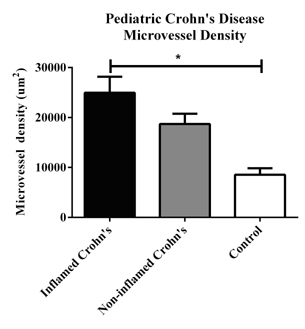|
Back to Annual Meeting Program
Link Between VEGF Expression, Angiogenesis and Inflammation in Pediatric Crohn's Disease
Jennifer L. Knod1, Kelly M. Crawford1, Mary R. Dusing1, Artur Chernoguz1, Margaret H. Collins2, Jason Frischer1
1. Division of Pediatric General and Thoracic Surgery, Cincinnati Children's Hospital Medical Center, Cincinnati, OH; 2. Division of Pathology, Cincinnati Children's Hospital Medical Center, Cincinnati, OH
Purpose:
Early-onset Crohn's disease (CD) accounts for 25% of cases but is distinct from adult-onset CD by a more severe disease activity index, increased immunosuppressant requirement, and more extensive intestinal involvement. The pathogenic link between chronic inflammatory diseases and angiogenesis prompted investigations into its role in inflammatory bowel disease. We hypothesize that VEGF driven angiogenesis plays a significant role in Crohn's disease inflammation.
Methods:
Pediatric patients (n=13), ages 12 to 16, at our institution having undergone resection involving the terminal ileum for CD were compared to controls (n=5) with non-inflammatory indications for resection. Additionally, from each Crohn's pathology specimen, inflamed and non-inflamed ileum were obtained for comparison. Samples were evaluated for inflammation using the Crohn's Histology Index of Severity (range 0-13) and for microvessel density by quantitative endothelial cell immunohistochemistry using CD31. Corresponding tissues were assessed for VEGF-A mRNA and protein expression by RT-PCR and Western blot respectively. Results expressed as mean▒SEM were analyzed for significance (P?0.05) by ANOVA and Student's t-test.
Results:
Inflammation scores were significantly increased (Fig 1) between inflamed CD and controls (5.8▒0.7 vs 0.62▒0.38, P<0.001), and between paired inflamed and non-inflamed ileum (5.8▒0.7 vs 1.2▒0.6, P< 0.001). Increased microvessel density was observed in both inflamed and non-inflamed CD groups compared to controls (inflamed 24,955▒3,202Ám2, non-inflamed 18,719▒2,050Ám2, control 9,032▒1,474Ám2), with statistical significance (P=0.008) only present between inflamed CD and control subjects (Fig 2). Expression of tissue VEGF-A mRNA was upregulated in CD (CD 8.5▒2.51 vs control 2.32▒0.58, P=0.034), and was associated with an increased trend in VEGF-A protein levels (VEGF/GAPDH, CD 3.96 vs control 2.20, P=0.53).
Conclusion:
Angiogenesis is associated with pediatric Crohn's disease as observed by increased microvessel density that correlates with greater inflammation in resected ileal specimens. At the molecular level, we demonstrate elevated VEGF transcription and protein levels, which implicates a VEGF pathway for angiogenesis associated inflammation in early-onset Crohn's disease. Further investigations regarding mechanism of angiogenesis, its relationship to inflammation, and effectiveness of anti-angiogenic therapies are warranted.

Fig 1 Inflammation score (range 0-13) of inflamed pediatric Crohn's disease ileum increased compared to both non-inflammed Crohn's diseae and control. Results expressed as mean ▒ SEM (*P <0.001).

Fig 2 Microvessel density (MVD) in pediatric Crohn's disease ileum (inflamed and non-inflamed) increased compared to control, detected by CD 31 quantitative immunohistochemical staining. Results expressed as mean ▒ SEM (*P = 0.008).
Back to Annual Meeting Program
|



